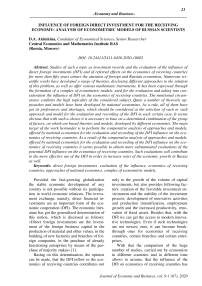Influence of foreign direct investment for the receiving economy: analysis of econometric models of Russian scientists
Автор: Akimkina D.A.
Журнал: Экономика и бизнес: теория и практика @economyandbusiness
Статья в выпуске: 9-1 (67), 2020 года.
Бесплатный доступ
Studies of such a topic as investment records and the evaluation of the influence of direct foreign investments (DFI) and of referred effects on the economics of receiving countries for more than fifty years attract the attention of foreign and Russian economists. Numerous scientific works have developed a range of theories, disclosing different approaches to the solution of this problem, as well as offer various mathematic instruments. It has been expressed through the formation of a complex of econometric models, used for the evaluation and taking into consideration the influence of DFI on the economics of receiving countries. The mentioned circumstance confirms the high topicality of the considered subject. Quite a number of theoretic approaches and models have been developed by national economists. As a rule, all of them have got its preferences and shortages, which should be considered at the selection of such or such approach and model for the evaluation and recording of the DFI in each certain case. It seems obvious that with such a choice it is necessary to base on a determined combination of the group of factors, on which are based theories and models, developed by different economists. The main target of the work hereunder is to perform the comparative analysis of approaches and models, offered by national economists for the evaluation and recording of the DFI influence on the economics of receiving countries. As a result of the comparative analysis of approaches and models, offered by national economists for the evaluation and recording of the DFI influence on the economics of receiving countries it seems possible to obtain more substantiated evaluations of the potential DFI influence on the economics of receiving countries. Such evaluations will contribute to the more effective use of the DFI in order to increase rates of the economic growth in Russia as well.
Direct foreign investments, evaluation of the influence, economics of receiving countries, approaches of national economics, complex of econometric models
Короткий адрес: https://sciup.org/170190096
IDR: 170190096 | DOI: 10.24411/2411-0450-2020-10682
Текст научной статьи Influence of foreign direct investment for the receiving economy: analysis of econometric models of Russian scientists
Provided the fast-growing globalization the stable economic development of any country is not possible without its participation in world economic relations. The investment exchange, namely, direct financial investments are an important form of the economic cooperation (DFI). The economic literature has got the generalized determination of this notion, which is disclosed as follows: «Direct foreign investments are the investment of the foreign business capital in the production of material and other values, in the building of new factories and branches of foreign companies, in the purchase of already functioning enterprises by means of the purchase of majority stakes» [1].
Basing on this determination, the opinion can be made, that the DFI inflow in the economics of receiving countries contributes not only to the growth of the volume of capital investments, but also provides following factors: creation of the favorable investment environment and the stability of the investment process, development of innovative activities and production intensification, employment growth and the increased productivity, renovation of fixed assets. Besides that, with the DFI we can get the access to modern innovative technologies. Even if such technologies are not newest ones, it can become breakthrough ones for economics of receiving countries, certain branches and certain enterprises.
With that the comparison of the huge number of studies, carried out by economists in different countries and in different time allows to assume, that the influence of the DFI on economics of receiving countries has got the multidirectional character. There are many examples enough, when DFI are being used for the suppression of local manufacturers, as well as for its purchase in order to eliminate potential competitors. Also we cannot exclude such risks as the transfer to the country of the obsolete equipment for the manufacturing of the production, being at the last stage of its life cycle [2]. The unhealthy institutional infrastructure can also become a serious obstacle for the DFI attraction. All these reasons restrain the obtaining of the expected positive effect from the DFI involvement [3].
In the most part of the research dedicated to studies of consequences of the DFI involvement in economics of receiving countries, as well as to the evaluation of related effects, the econometric modeling is applied. Foreign and Russian scientists have developed numerous methods for the evaluation and assessment of the DFI influence on the receiving economics, both at the country and regional level, as well as at the branch or enterprise level [4].
Список литературы Influence of foreign direct investment for the receiving economy: analysis of econometric models of Russian scientists
- Ivanchenkо I.S., Nalivaiskiy V.Y. Involvement of direct foreign investments to Russia // Financial analytics: problems and solutions. - 2014. - № 38. - P. 2-12.
- Lipsey R.E. Home and host country effects of FDI // NBER working paper №9293. 2002.
- Аkimkinа D.А. Direct foreign investments in the Russian industrial policy // Economic analysis: theory and practice. - 2013. - № 3 (306). - P. 27-37.
- Vasilievskaya S.V. Меthodic issues of the evaluation of the influence of direct foreign investments on the business development in the receiving region // Теrritory of new possibilities. Herald of Vladivostok State University of Economics and Service. - 2010. - №2 (6). - P. 134-141.
- Vernon R. International Investment and International Trade in the Product Cycle // Quarterly Journal of Economics. - 1966. - №80 (2). - P. 190-207. DOI: 10.2307/1880689


